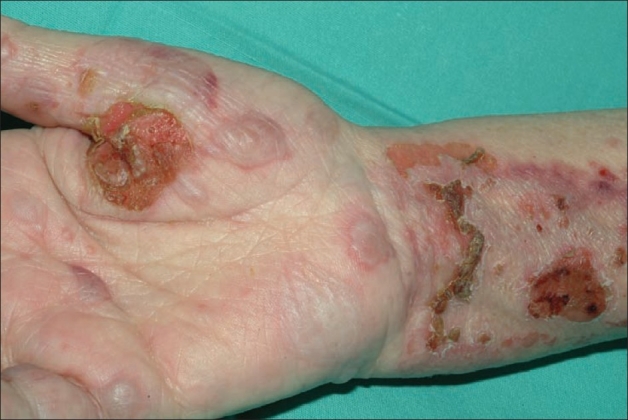Playlist
Show Playlist
Hide Playlist
Quick Review: Bullous Diseases
-
Slides Bullous Diseases.pdf
-
Download Lecture Overview
00:02 All right. So, for this next section, we're going to review some of the material we've talked about by going through 3 questions. 00:07 After I ask the question, feel free to pause the slides for a moment, and then come back and we'll go through the answers. 00:15 So question 1. Which of the following would have a negative Nikolsky sign? Remember, the Nikolsky sign is a very useful test to help us to decide whether or not the lesion is occurring within the epidermis, that is, there is an attack on the keratinocytes, versus if the disease is at the border between the epidermis and the dermal layer underneath. 00:42 So, Stevens-Johnson syndrome. This is an immune attack on the epidermis, within the keratinocytes. It should have a positive Nikolsky sign. Pemphigus vulgaris, same thing. It's the keratinocytes. It's an antibody, the anti-desmoglein antibody within the epidermis. Staphylococcal scalded skin syndrome also involves an attack on the epidermis and the keratinocytes. So the only one on this list that would lead to tense bullae and a negative Nikolsky is actually porphyria cutanea tarda. 01:12 Let's go on to our next question. 01:17 Which of the following is not associated with pemphigus vulgaris? Okay, so let's review. Pemphigus vulgaris. 01:32 Pruritic urticarial lesions? Might see that. It's possible. More likely, you'd see that with bullous pemphigoid. 01:41 Extensive mucosal involvement? Absolutely. That's a part of pemphigus vulgaris. Typical age, 40-60 years old, definitely. 01:48 Anti-desmoglein immunoglobulin antibodies, absolutely. 01:52 And flaccid bullae and hemorrhagic erosions? Those are a characteristic feature of pemphigus vulgaris. 01:58 So, it's really those pruritic urticarial lesions, which you're more likely to see with bullous pemphigoid, and that's the answer to this question. 02:05 Let's move on to our third question. 02:10 Which of the following is not associated with staphylococcal scalded skin syndrome? Okay. Going through each of these answers, one at a time. 02:25 Extensive superficial skin sloughing? That's a characteristic feature of this syndrome. 02:30 Typical age, under 5 years old. As we discussed, it's mostly a disease of babies. 02:35 It's caused by a systemically absorbed exfoliative toxin. 02:39 That's correct. Comes from Staphylococcus aureus. 02:42 Extensive mucosal involvement? As we mentioned, even though it can look a lot like something like Stevens-Johnson syndrome or even toxic epidermal necrolysis, the big distinction is that there is no mucosal involvement, or very rarely would you find that. And, of course, you do treat it with supportive care and systemic antibiotics since it is a self-resolving problem. 03:04 And with that, I think we're done.
About the Lecture
The lecture Quick Review: Bullous Diseases by Stephen Holt, MD, MS is from the course Allergic and Immune-mediated Skin Disorders.
Included Quiz Questions
Which of the following is associated with porphyria cutanea tarda?
- Negative Nikolsky sign
- Mucosal involvement
- Flaccid bullae
- T-cell–mediated autoimmune disease
What is the classic clinical presentation of pemphigus vulgaris?
- Flaccid bullae and hemorrhagic erosions
- Negative Nikolsky sign
- Tense bullae with extensive mucosal involvement
- Pruritic urticarial skin lesions
- Skin lesions that are aggravated by sun exposure, alcohol, and some medications
Customer reviews
5,0 of 5 stars
| 5 Stars |
|
1 |
| 4 Stars |
|
0 |
| 3 Stars |
|
0 |
| 2 Stars |
|
0 |
| 1 Star |
|
0 |
nice recap and highlight of important points to distinguish the different diseases that share characteristics




